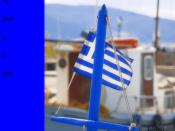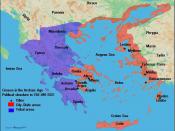When sculpted in 450 B.C.E., the Diskobolos was originally crafted in bronze. The sculptor, Myron, used a technique called hollow-casting which was common for Greek sculptors of the Archaic period. The title of the sculpture, Diskobolos, means "disk thrower" in Greek. This sculpture has been reproduced thousands of times, including many marble copies made by the Romans, and plaster casts like the one in our library.
The Diskobolos is a very detailed sculpture. The musculature of it shows the athletic ability of Greek athletes. The athlete is sculpted in the nude like many of the other Greek sculptures. The sculpture is attempting to capture the art of athletic ability, during strenuous tasks. The athlete is in the climax of his action. Yet in the action, the athlete is concentrating on his task. The lack of expression on his face and the glare of the eyes portray his concentration.
He is leaning forward at the hip. His upper body is twisted showing the torque needed to propel the discus. The athlete's legs are bent at the knees. With all the action going on in his body, the athlete still maintains his center of gravity which is necessary for him to complete the throw. The muscles over the entire sculpture are well defined. His shoulders are clearly defined from the rest of his arms. His chest has well defined pectoral muscles as well as abdominal muscles.
Athletic ability was very important to the Greek's. For the first time in history we have art portraying athletes in action. Today the entire world still celebrates the Greek Olympic Games. The gamers were created more than 2500 years ago by the Greeks. Today the winners of the games receive medals, but in ancient Greece the athletes received crowns of olives. The athletes were...


